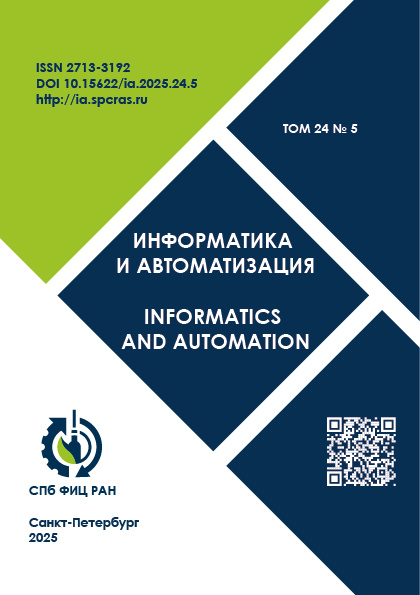Том 22, № 1 (2023)
Робототехника, автоматизация и системы управления
Совместное управление сигналами светофоров и траекториями движения транспортных средств
Аннотация
 5-32
5-32


Обмен навигационной информацией для оперативного управления дорожным движением
Аннотация
 33-56
33-56


Обзор автоматических систем опрыскивания с переменной скоростью, основанной на анализе характеристик растительного покрова фруктового сада
Аннотация
Использование пестицидов и загрязнение окружающей среды в садах можно значительно снизить, сочетая опрыскивание с переменной скоростью с пропорциональными системами управления. В настоящее время фермеры могут использовать опрыскивание с переменной скоростью для применения средств от сорняков только там, где они необходимы, что обеспечивает экологически чистые и экономичные химические средства для защиты растений. Кроме того, серьезной проблемой является ограничение использования пестицидов в качестве средств защиты растений (СЗР) при сохранении надлежащего отложения растительного покрова. Кроме того, автоматические опрыскиватели, которые регулируют норму внесения в соответствии с размером и формой садовых насаждений, показали значительный потенциал для сокращения использования пестицидов. Для автоматического распыления в существующем исследовании использовались искусственная нейронная сеть (ИНС) и машинное обучение. Кроме того, эффективность опрыскивания можно повысить за счет снижения потерь при распылении из-за осаждения на грунт и нецелевого сноса. Таким образом, это исследование включает в себя тщательное изучение существующих методов опрыскивания с переменной скоростью в садах. Помимо предоставления примеров их прогнозов и краткого рассмотрения влияния на параметры опрыскивания, в нем также представлены различные альтернативы предотвращению чрезмерного использования пестицидов и исследуются их преимущества и недостатки.
 57-86
57-86


Машинно синтезированное управление нелинейным динамическим объектом на основе оптимального расположения точек равновесия
Аннотация
 87-109
87-109


Искусственный интеллект, инженерия данных и знаний
Метод векторизации спутниковых снимков на основе их разложения по топологическим особенностям
Аннотация
 110-145
110-145


Модель машинного обучения для определения оптимальной стратегии в онлайн-аукционе
Аннотация
 146-167
146-167


Метод формирования цифровой тени процесса перемещения человека на основе объединения систем захвата движений
Аннотация
 168-189
168-189


Выявление характеристик индивидуального человеческого капитала сотрудников организации по данным самоотчетов о профессиональных навыках и личностным особенностям
Аннотация
 190-214
190-214












